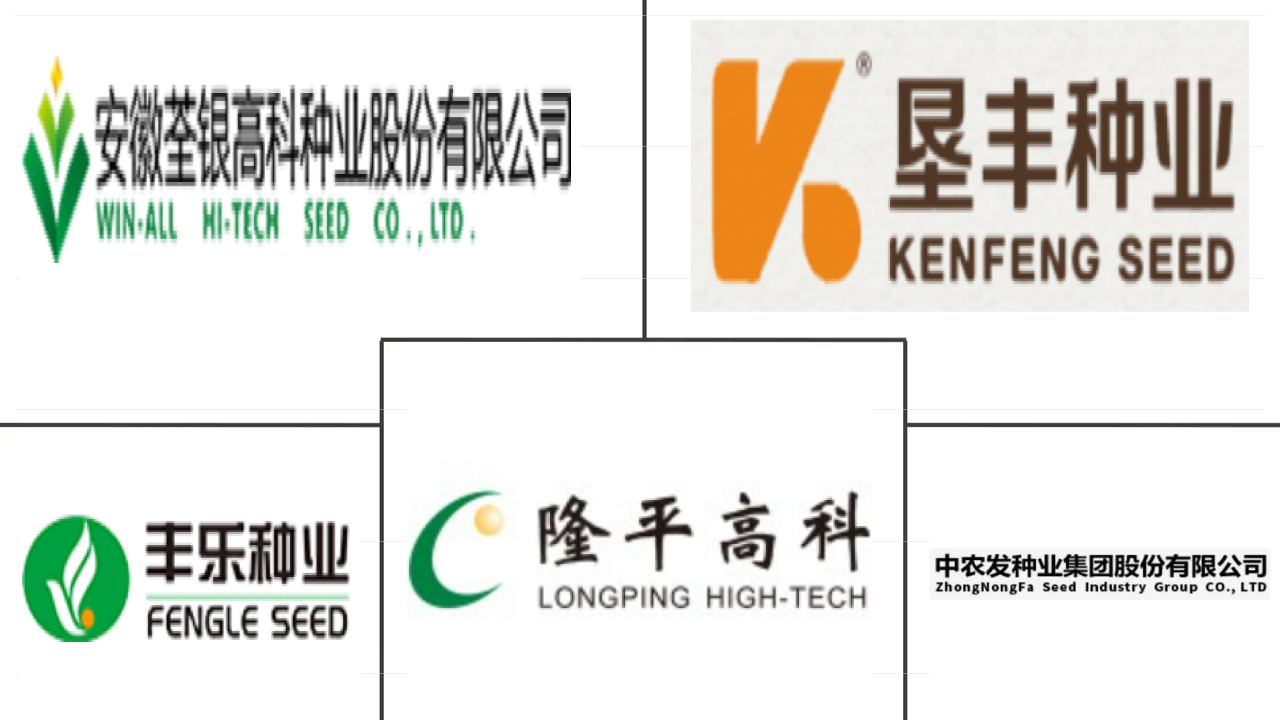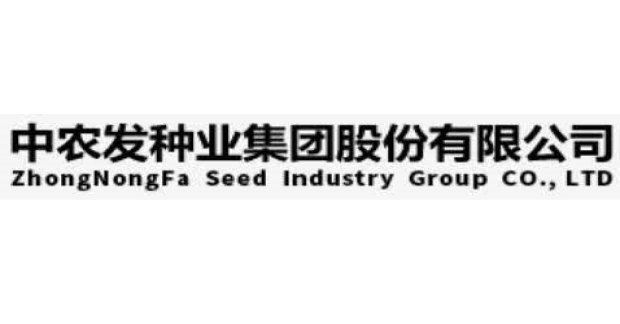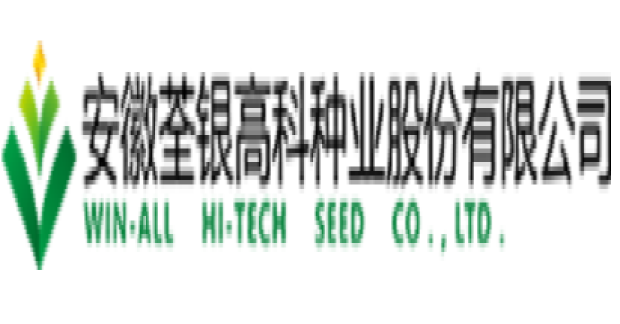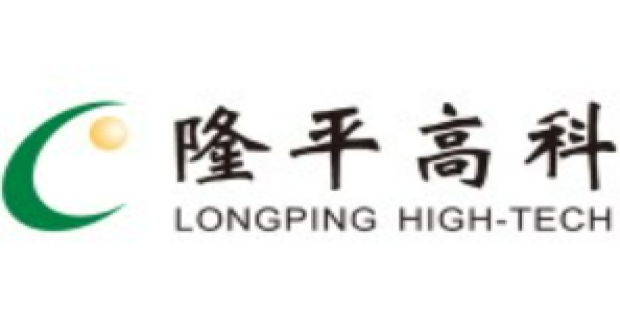China Rice Seed Market Size
|
|
Study Period | 2017 - 2030 |
|
|
Market Size (2024) | USD 1.83 Billion |
|
|
Market Size (2030) | USD 2.08 Billion |
|
|
Largest Share by Breeding Technology | Hybrids |
|
|
CAGR (2024 - 2030) | 2.17 % |
|
|
Fastest Growing by Breeding Technology | Hybrids |
Major Players |
||

|
||
|
*Disclaimer: Major Players sorted in no particular order |
China Rice Seed Market Analysis
The China Rice Seed Market size is estimated at 1.83 billion USD in 2024, and is expected to reach 2.08 billion USD by 2030, growing at a CAGR of 2.17% during the forecast period (2024-2030).
1.83 Billion
Market Size in 2024 (USD)
2.08 Billion
Market Size in 2030 (USD)
2.10 %
CAGR (2017-2023)
2.17 %
CAGR (2024-2030)
Largest Market by Breeding Technology
60.36 %
value share, Hybrids, 2023
The largest share of hybrids is due to their high area under cultivation for all hybrid crops and their advantages, such as disease resistance, high yield, and wider adaptability.
Fastest-growing Market by Breeding Technology
2.19 %
Projected CAGR, Hybrids, 2024-2030
The fastest growth of hybrids is associated with their characteristics, such as high yield and disease resistance, along with the development and approval of transgenic hybrid varieties.
Leading Market Player1
7.04 %
market share, Zhongnongfa Seed Industry Group Co. Ltd, 2022

It is one of the largest companies producing rice seeds. It is also expanding its operations through partnerships with global players and product innovations for local climatic conditions.
Leading Market Player2
5.06 %
market share, Anhui Tsuen Yin Hi-Tech Seed Industry Co. Ltd, 2022

It is a local seed company in China with a rich portfolio of hybrid rice. Indica-type super hybrid rice seeds are cultivated in 16 major rice-producing provinces in the country.
Leading Market Player3
4.68 %
market share, Yuan Longping High-Tech Agriculture Co. Ltd, 2022

It is one of the leading rice seed companies with a wider portfolio in the rice seed segment. The company is primarily focused on product innovation and partnerships.
Open-pollinated varieties and hybrid varieties of rice seeds held almost equal markets in China, and the ability of hybrid rice seeds to resist various diseases is driving the market
- In China, open-pollinated varieties and hybrid derivatives (OPVs) dominated the market, which accounted for about 65.7% of the market in 2022. It is associated with the high volume of seed requirements for planting and low-cost seeds compared to hybrids.
- The low cost of open-pollinated varieties, high adoption to local conditions, options for farm-saved seeds, and timely non-availability of hybrids are projected to drive the demand for open-pollinated and hybrid derivative rice seeds in China during the forecast period.
- Hybrid rice seeds accounted for 34.3% of the market value in China’s rice seed market in 2022. These hybrid rice seeds offer high-yielding characteristics and resistance to biotic and abiotic stresses.
- In the Chinese hybrid rice seed market, transgenic hybrids accounted for the market share of 83.3% in 2022 due to their resistance to major Lepidopteran insect pests and tolerance to common herbicides. Therefore, the demand for hybrids is expected to increase in the country during the forecast period.
- In the transgenic hybrid category, the majority share of the market was held by insect-resistant transgenic hybrids. This is primarily because, in China, insect-resistant transgenic traits are the only genetically modified rice crops that have received approval for commercial cultivation.
- In China, non-transgenic hybrids accounted for 16.7% of the hybrid rice seed market value in 2022. The market increased by 10.4% between 2017 and 2022, mainly due to the high adaption of hybrid seeds compared to traditional or inbreed seeds in the country.
- The growing area under cultivation of rice and the respective benefits of the OPV and hybrid seeds are anticipated to drive the market during the forecast period.
China Rice Seed Market Trends
Rice was second-largest crop cultivated driven by the government's support and the high per capita consumption rate
- China is one of the major rice-producing countries in Asia-Pacific. In 2022, it accounted for 21.3% of the of the region's rice cultivation area. The higher share is due to the higher consumption demand in the country, as it is a staple food crop. In 2022, China accounted for 30.4 million hectares under rice cultivation, which increased by 1.6% when compared to 2019. The area showed a decline in 2019 compared to the previous three years due to a shift in the corn area, driven by a rise in corn prices and demand in the international market. Hunan Province has the largest rice planting area in the country, with a total of 4.1 million hectares.
- Rice is China's most important food crop, and it is highly dependent on irrigation. However, an increasing number of extreme drought events have challenged rice production in many regions, resulting in a decreased harvest area. For instance, the harvest area decreased from 30.3 million hectares in 2020 to 30.1 million hectares in 2021.
- Domestic rice prices remained stable and are expected to continue to increase more than international rice prices, especially after the government increased rice procurement prices in 2022. The price will be USD 392 per metric ton for early Indica rice, up by USD 6.3 per ton from 2021, and USD 413 per ton for Japonica rice, up USD 3.1 per ton from 2021. The increase in the MSP of rice farmers is expected to increase the sowing area, thereby increasing the growth of commercial seeds.
- The transgenic rice is anticipated to increase because of the increasing acceptance of technology by farmers in the country. The acreage of transgenic rice seed has been expanding in recent years because farmers are getting higher crop yields and reduced pesticide use.
Disease-resistant traits are preferred by rice producers in China, primarily due to the prevalence of diseases such as rice blast and bacterial blight in rice fields
- Rice production in China has grown increasingly during the past few decades, which is mainly due to increased yields of grain rather than increased planting areas across China. Due to the availability of high-yielding traits, production and productivity were enhanced largely in the country.
- Disease resistance is the most popular trait, while others, such as drought tolerance, insect resistance, moisture stress, wider availability, and effective tillers with panicles, are also cultivated in the country. In China, the major disease-resistant traits that are popularly used by seed companies are resistance to bacterial blight, brown plant hoppers, rice blasts, and heat resistance at the heading stage, as they lead to heavy yield loss. Furthermore, insect resistance traits, especially toward brown plant hoppers, and disease resistance toward rice blast disease and bacterial leaf blight are in high demand and largely cultivated by farmers. Companies such as Yuan Long-Ping Hi-tech companies, Win-All High-Tech, and Beidahuang Kenfeng Seed Co. Ltd are actively involved in breeding these rice varieties in the country.
- Drought tolerance is one of the major traits produced by seed companies as there have been changes in the climatic conditions, which has led to a high demand for this seed variety by growers. For instance, in 2022, China suffered drier conditions than normal rainfall conditions, which is expected to help increase the demand for drought-tolerant seed varieties.
- The demand for rice seeds with improved traits is increasing as farmers are turning toward sustainable agriculture. Therefore, it is anticipated that the market for seeds with improved traits will witness a positive trend during the forecast period.
OTHER KEY INDUSTRY TRENDS COVERED IN THE REPORT
- Transgenic breeding dominated the market because it increased opportunities for genetic improvement of rice and reduced the damage from pests
China Rice Seed Industry Overview
The China Rice Seed Market is fragmented, with the top five companies occupying 23.43%. The major players in this market are Anhui Tsuen Yin Hi-Tech Seed Industry Co. Ltd, Beidahuang Kenfeng Seed Co. Ltd, Hefei Fengle Seed Industry Co. Ltd, Yuan Longping High-Tech Agriculture Co. Ltd and Zhongnongfa Seed Industry Group Co. Ltd (sorted alphabetically).
China Rice Seed Market Leaders
Anhui Tsuen Yin Hi-Tech Seed Industry Co. Ltd
Beidahuang Kenfeng Seed Co. Ltd
Hefei Fengle Seed Industry Co. Ltd
Yuan Longping High-Tech Agriculture Co. Ltd
Zhongnongfa Seed Industry Group Co. Ltd
Other important companies include Beijing Golden Nonghua Seed Industry Technology Co. Ltd, Groupe Limagrain, Jiangsu Hongqi Seed Industry Co. Ltd, Jiangsu Zhongjiang Seed Industry Co. Ltd, Kehuiseed Co. Ltd.
*Disclaimer: Major Players sorted in alphabetical order.
China Rice Seed Market News
- June 2021: Jiangsu Zhongjiang Seed Industry Co. Ltd launched a hybrid variety of rice called 'Taixiangjing 1402,' which is a soft japonica variety with good taste and aroma.
- June 2020: BASF and Yuan Longping High-Tech Agriculture Co. Ltd formed a partnership to co-develop and commercialize new non-GMO rice seed production to boost agricultural productivity for farmers in China.
Free with this Report
We provide a complimentary and exhaustive set of data points on regional and country-level metrics that present the fundamental structure of the industry. Presented in the form of 90+ free charts, the section covers difficult-to-find data from various regions regarding the area under cultivation for different crops within the scope
China Rice Seed Market Report - Table of Contents
1. EXECUTIVE SUMMARY & KEY FINDINGS
2. REPORT OFFERS
3. INTRODUCTION
- 3.1 Study Assumptions & Market Definition
- 3.2 Scope of the Study
- 3.3 Research Methodology
4. KEY INDUSTRY TRENDS
- 4.1 Area Under Cultivation
- 4.2 Most Popular Traits
- 4.3 Breeding Techniques
- 4.4 Regulatory Framework
- 4.5 Value Chain & Distribution Channel Analysis
5. MARKET SEGMENTATION (includes market size in Value in USD, Forecasts up to 2030 and analysis of growth prospects)
-
5.1 Breeding Technology
- 5.1.1 Hybrids
- 5.1.1.1 Non-Transgenic Hybrids
- 5.1.1.2 Transgenic Hybrids
- 5.1.1.2.1 Insect Resistant Hybrids
- 5.1.2 Open Pollinated Varieties & Hybrid Derivatives
6. COMPETITIVE LANDSCAPE
- 6.1 Key Strategic Moves
- 6.2 Market Share Analysis
- 6.3 Company Landscape
-
6.4 Company Profiles
- 6.4.1 Anhui Tsuen Yin Hi-Tech Seed Industry Co. Ltd
- 6.4.2 Beidahuang Kenfeng Seed Co. Ltd
- 6.4.3 Beijing Golden Nonghua Seed Industry Technology Co. Ltd
- 6.4.4 Groupe Limagrain
- 6.4.5 Hefei Fengle Seed Industry Co. Ltd
- 6.4.6 Jiangsu Hongqi Seed Industry Co. Ltd
- 6.4.7 Jiangsu Zhongjiang Seed Industry Co. Ltd
- 6.4.8 Kehuiseed Co. Ltd
- 6.4.9 Yuan Longping High-Tech Agriculture Co. Ltd
- 6.4.10 Zhongnongfa Seed Industry Group Co. Ltd
- *List Not Exhaustive
7. KEY STRATEGIC QUESTIONS FOR SEEDS CEOS
8. APPENDIX
-
8.1 Global Overview
- 8.1.1 Overview
- 8.1.2 Porter’s Five Forces Framework
- 8.1.3 Global Value Chain Analysis
- 8.1.4 Global Market Size and DROs
- 8.2 Sources & References
- 8.3 List of Tables & Figures
- 8.4 Primary Insights
- 8.5 Data Pack
- 8.6 Glossary of Terms
List of Tables & Figures
- Figure 1:
- AREA UNDER CULTIVATION OF RICE, HECTARE, CHINA, 2017-2022
- Figure 2:
- VALUE SHARE OF MAJOR RICE TRAITS, %, CHINA, 2022
- Figure 3:
- VALUE SHARE OF RICE BREEDING TECHNIQUES, %, CHINA, 2022
- Figure 4:
- VOLUME OF RICE SEED, METRIC TON, CHINA, 2017 - 2030
- Figure 5:
- VALUE OF RICE SEED, USD, CHINA, 2017 - 2030
- Figure 6:
- VOLUME OF RICE SEED BY BREEDING TECHNOLOGY CATEGORIES, METRIC TON, CHINA, 2017 - 2030
- Figure 7:
- VALUE OF RICE SEED BY BREEDING TECHNOLOGY CATEGORIES, USD, CHINA, 2017 - 2030
- Figure 8:
- VOLUME SHARE OF RICE SEED BY BREEDING TECHNOLOGY CATEGORIES, %, CHINA, 2017 VS 2023 VS 2030
- Figure 9:
- VALUE SHARE OF RICE SEED BY BREEDING TECHNOLOGY CATEGORIES, %, CHINA, 2017 VS 2023 VS 2030
- Figure 10:
- VOLUME OF RICE SEED BY HYBRIDS CATEGORIES, METRIC TON, CHINA, 2017 - 2030
- Figure 11:
- VALUE OF RICE SEED BY HYBRIDS CATEGORIES, USD, CHINA, 2017 - 2030
- Figure 12:
- VOLUME SHARE OF RICE SEED BY HYBRIDS CATEGORIES, %, CHINA, 2017 VS 2023 VS 2030
- Figure 13:
- VALUE SHARE OF RICE SEED BY HYBRIDS CATEGORIES, %, CHINA, 2017 VS 2023 VS 2030
- Figure 14:
- VOLUME OF NON-TRANSGENIC HYBRIDS RICE SEED, METRIC TON, CHINA, 2017 - 2030
- Figure 15:
- VALUE OF NON-TRANSGENIC HYBRIDS RICE SEED, USD, CHINA, 2017 - 2030
- Figure 16:
- VALUE SHARE OF NON-TRANSGENIC HYBRIDS RICE SEED BY HYBRIDS, %, CHINA, 2023 AND 2030
- Figure 17:
- VOLUME OF RICE SEED BY TRANSGENIC HYBRIDS CATEGORIES, METRIC TON, CHINA, 2017 - 2030
- Figure 18:
- VALUE OF RICE SEED BY TRANSGENIC HYBRIDS CATEGORIES, USD, CHINA, 2017 - 2030
- Figure 19:
- VOLUME SHARE OF RICE SEED BY TRANSGENIC HYBRIDS CATEGORIES, %, CHINA, 2017 VS 2023 VS 2030
- Figure 20:
- VALUE SHARE OF RICE SEED BY TRANSGENIC HYBRIDS CATEGORIES, %, CHINA, 2017 VS 2023 VS 2030
- Figure 21:
- VOLUME OF INSECT RESISTANT HYBRIDS RICE SEED, METRIC TON, CHINA, 2017 - 2030
- Figure 22:
- VALUE OF INSECT RESISTANT HYBRIDS RICE SEED, USD, CHINA, 2017 - 2030
- Figure 23:
- VALUE SHARE OF INSECT RESISTANT HYBRIDS RICE SEED BY TRANSGENIC HYBRIDS, %, CHINA, 2023 AND 2030
- Figure 24:
- VOLUME OF OPEN POLLINATED VARIETIES & HYBRID DERIVATIVES RICE SEED, METRIC TON, CHINA, 2017 - 2030
- Figure 25:
- VALUE OF OPEN POLLINATED VARIETIES & HYBRID DERIVATIVES RICE SEED, USD, CHINA, 2017 - 2030
- Figure 26:
- VALUE SHARE OF OPEN POLLINATED VARIETIES & HYBRID DERIVATIVES RICE SEED BY BREEDING TECHNOLOGY, %, CHINA, 2023 AND 2030
- Figure 27:
- MOST ACTIVE COMPANIES BY NUMBER OF STRATEGIC MOVES, COUNT, CHINA, 2017-2023
- Figure 28:
- MOST ADOPTED STRATEGIES, COUNT, CHINA, 2017-2023
- Figure 29:
- VALUE SHARE OF MAJOR PLAYERS, %, CHINA, 2023
China Rice Seed Industry Segmentation
Hybrids, Open Pollinated Varieties & Hybrid Derivatives are covered as segments by Breeding Technology.
- In China, open-pollinated varieties and hybrid derivatives (OPVs) dominated the market, which accounted for about 65.7% of the market in 2022. It is associated with the high volume of seed requirements for planting and low-cost seeds compared to hybrids.
- The low cost of open-pollinated varieties, high adoption to local conditions, options for farm-saved seeds, and timely non-availability of hybrids are projected to drive the demand for open-pollinated and hybrid derivative rice seeds in China during the forecast period.
- Hybrid rice seeds accounted for 34.3% of the market value in China’s rice seed market in 2022. These hybrid rice seeds offer high-yielding characteristics and resistance to biotic and abiotic stresses.
- In the Chinese hybrid rice seed market, transgenic hybrids accounted for the market share of 83.3% in 2022 due to their resistance to major Lepidopteran insect pests and tolerance to common herbicides. Therefore, the demand for hybrids is expected to increase in the country during the forecast period.
- In the transgenic hybrid category, the majority share of the market was held by insect-resistant transgenic hybrids. This is primarily because, in China, insect-resistant transgenic traits are the only genetically modified rice crops that have received approval for commercial cultivation.
- In China, non-transgenic hybrids accounted for 16.7% of the hybrid rice seed market value in 2022. The market increased by 10.4% between 2017 and 2022, mainly due to the high adaption of hybrid seeds compared to traditional or inbreed seeds in the country.
- The growing area under cultivation of rice and the respective benefits of the OPV and hybrid seeds are anticipated to drive the market during the forecast period.
| Breeding Technology | Hybrids | Non-Transgenic Hybrids | |
| Transgenic Hybrids | Insect Resistant Hybrids | ||
| Breeding Technology | Open Pollinated Varieties & Hybrid Derivatives |
Market Definition
- Commercial Seed - For the purpose of this study, only commercial seeds have been included as part of the scope. Farm-saved Seeds, which are not commercially labeled are excluded from scope, even though a minor percentage of farm-saved seeds are exchanged commercially among farmers. The scope also excludes vegetatively reproduced crops and plant parts, which may be commercially sold in the market.
- Crop Acreage - While calculating the acreage under different crops, the Gross Cropped Area has been considered. Also known as Area Harvested, according to the Food & Agricultural Organization (FAO), this includes the total area cultivated under a particular crop across seasons.
- Seed Replacement Rate - Seed Replacement Rate is the percentage of area sown out of the total area of crop planted in the season by using certified/quality seeds other than the farm-saved seed.
- Protected Cultivation - The report defines protected cultivation as the process of growing crops in a controlled environment. This includes greenhouses, glasshouses, hydroponics, aeroponics, or any other cultivation system that protects the crop against any abiotic stress. However, cultivation in an open field using plastic mulch is excluded from this definition and is included under open field.
| Keyword | Definition |
|---|---|
| Row Crops | These are usually the field crops which include the different crop categories like grains & cereals, oilseeds, fiber crops like cotton, pulses, and forage crops. |
| Solanaceae | These are the family of flowering plants which includes tomato, chili, eggplants, and other crops. |
| Cucurbits | It represents a gourd family consisting of about 965 species in around 95 genera. The major crops considered for this study include Cucumber & Gherkin, Pumpkin and squash, and other crops. |
| Brassicas | It is a genus of plants in the cabbage and mustard family. It includes crops such as carrots, cabbage, cauliflower & broccoli. |
| Roots & Bulbs | The roots and bulbs segment includes onion, garlic, potato, and other crops. |
| Unclassified Vegetables | This segment in the report includes the crops which don’t belong to any of the above-mentioned categories. These include crops such as okra, asparagus, lettuce, peas, spinach, and others. |
| Hybrid Seed | It is the first generation of the seed produced by controlling cross-pollination and by combining two or more varieties, or species. |
| Transgenic Seed | It is a seed that is genetically modified to contain certain desirable input and/or output traits. |
| Non-Transgenic Seed | The seed produced through cross-pollination without any genetic modification. |
| Open-Pollinated Varieties & Hybrid Derivatives | Open-pollinated varieties produce seeds true to type as they cross-pollinate only with other plants of the same variety. |
| Other Solanaceae | The crops considered under other Solanaceae include bell peppers and other different peppers based on the locality of the respective countries. |
| Other Brassicaceae | The crops considered under other brassicas include radishes, turnips, Brussels sprouts, and kale. |
| Other Roots & Bulbs | The crops considered under other roots & bulbs include Sweet Potatoes and cassava. |
| Other Cucurbits | The crops considered under other cucurbits include gourds (bottle gourd, bitter gourd, ridge gourd, Snake gourd, and others). |
| Other Grains & Cereals | The crops considered under other grains & cereals include Barley, Buck Wheat, Canary Seed, Triticale, Oats, Millets, and Rye. |
| Other Fibre Crops | The crops considered under other fibers include Hemp, Jute, Agave fibers, Flax, Kenaf, Ramie, Abaca, Sisal, and Kapok. |
| Other Oilseeds | The crops considered under other oilseeds include Ground nut, Hempseed, Mustard seed, Castor seeds, safflower seeds, Sesame seeds, and Linseeds. |
| Other Forage Crops | The crops considered under other forages include Napier grass, Oat grass, White clover, Ryegrass, and Timothy. Other forage crops were considered based on the locality of the respective countries. |
| Pulses | Pigeon peas, Lentils, Broad and horse beans, Vetches, Chickpeas, Cowpeas, Lupins, and Bambara beans are the crops considered under pulses. |
| Other Unclassified Vegetables | The crops considered under other unclassified vegetables include Artichokes, Cassava Leaves, Leeks, Chicory, and String beans. |
Research Methodology
Mordor Intelligence follows a four-step methodology in all our reports.
- Step-1: IDENTIFY KEY VARIABLES: In order to build a robust forecasting methodology, the variables and factors identified in Step-1 are tested against available historical market numbers. Through an iterative process, the variables required for market forecast are set and the model is built on the basis of these variables.
- Step-2: Build a Market Model: Market-size estimations for the forecast years are in nominal terms. Inflation is not a part of the pricing, and the average selling price (ASP) is kept constant throughout the forecast period.
- Step-3: Validate and Finalize: In this important step, all market numbers, variables and analyst calls are validated through an extensive network of primary research experts from the market studied. The respondents are selected across levels and functions to generate a holistic picture of the market studied.
- Step-4: Research Outputs: Syndicated Reports, Custom Consulting Assignments, Databases, and Subscription Platforms








